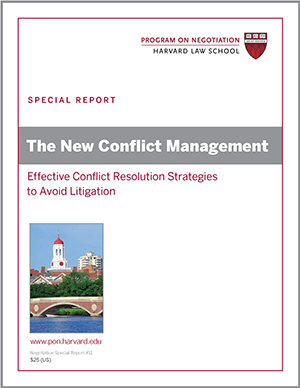
Sooner or later, almost all of us will find ourselves trying to cope with how to manage conflict at work. At the office, we may struggle to work through high-pressure situations with people with whom we have little in common. We need a special set of strategies to calm tempers, restore order, and meet each side’s interests.
The following three strategies will help you learn how to manage conflict at work.
1. Put formal systems in place.
Conflict in the workplace often arises when resentment, anger, and other negative emotions are left to fester. An accidental slight can lead into a full-blown dispute if the parties involved fail to address it explicitly. As a consequence, workplace conflict is often managed one dispute at a time, an approach that is inefficient and costly.
In recent years, organizations seeking to determine how to manage conflict at work increasingly have recognized the benefits of putting in place a formalized system for addressing conflict in the workplace. In an article in the Negotiation Briefings newsletter, Harvard Law School professors Frank E. A. Sander and Robert C. Bordone recommend that organizations engage in dispute system design—the process of diagnosing, designing, implementing, and evaluating an effective method of resolving conflicts in an organization. Those with basic experience with dispute-resolution processes such as negotiation, mediation, and arbitration, should be able to help their organization establish a dispute-resolution process.
One of the main goals of dispute system design, or DSD, should be to support low-cost, less invasive approaches to managing workplace conflict before moving on to more costly, riskier approaches. For example, an organization might encourage or require employees in conflict to engage in mediation before moving on to an arbitration hearing. In addition, write Sander and Bordone, employees should be able to tap into the dispute-resolution process at different points throughout the organization—for example, through their supervisor, an HR staff member, or some other leader—lest they avoid the system due to distrust of one person in particular.
Setting up a dispute system can be a complex process, but it will almost inevitably promote a more efficient means of managing workplace conflict than a case-by-case approach.
2. Promote better feedback.
Workplace conflict often arises because co-workers have difficulty giving one another effective feedback, or any feedback at all. When we fail to let people know how they can improve, our frustration grows as their mistakes mount. Similarly, if we give unconstructive feedback—feedback that is vague, very negative, or too personal—we can create destructive workplace conflict.
We need to learn to give more effective feedback and teach others in our organization to deliver meaningful and useful feedback as well. People who give good feedback ask questions, stay positive, give details, and describe how the situation makes them feel, writes Program on Negotiation managing director Susan Hackley in Negotiation Briefings. Leaders also need to make it easy for people to raise concerns.
In their 2014 book Thanks for the Feedback: The Science and Art of Receiving Feedback Well, Douglas Stone and Sheila Heen offer advice on accepting feedback in a constructive manner—even when the feedback isn’t delivered constructively. We all need to learn to identify personal triggers that cause us to take perceived criticism personally, for example.
3. Focus on the problem, not the people.
When deciding how to manage conflict at work, try to focus on the problem rather than the personalities involved, recommends Hackley. Because conflict tends to promote competition and antagonism, you should strive to frame the situation in a positive light. For example, focus on the potential benefits to the organization if you are able to resolve the workplace conflict rather than on the potential negatives if you have difficulty doing so.
In addition, when dealing with conflict at work, remember that people tend to view conflicts quite differently, based on their individual perspective. Our perceptions of what went wrong tend to be self-serving. With each person believing he or she is “right” and the other person is “wrong,” it’s no wonder conflicts often fester in organizations.
For this reason, it’s crucial to start off your workplace conflict resolution efforts by taking a joint problem-solving approach. Ask open-ended questions and test your assumptions, advises Hackley. Make sure that each party has ample time to express his or her views without interruption.
When figuring out how to manage conflict at work, we need to remember the importance of exploring the deeper interests underlying the other party’s positions. When you listen closely, you will go a long way toward building trust and resolving difficult situations.
Does your organization have a formal process for resolving workplace disputes?





What a wonderful article! I am familiar with the recent market trends with businesses looking for a more cost effective approach to deal with such conflicts. I am curious to know if you have any insight on the value proposition or benefit individuals would have with a clinical background in such market?